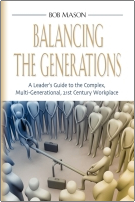 Get your copy now!
Get your copy now!
I'm proud to announce the release of my new book, Balancing the Generations: A Leader's Guide to the Complex, Multi-Generational, 21st Century Workplace
The book examines each generation, dispels common myths, and gives leaders tools to build a more effective organization by helping them recognize and take advantage of each generation's strengths.
If you were born between 1900 and 2000 and are in the 21st Century workplace, you need to read this book!
PLANNING TO EXCEL: STRATEGIC PLANNING THAT WORKS
 Get your copy now and Plan to Excel!
Get your copy now and Plan to Excel!
Plan for success
train your leaders to lead
and help them excel!!
With all the despair
about the economic situation,
this is the time
to plan and train
for a positive future.
Plan for success
and train your managers to lead! |

Leading Change When It's Your Idea
By Bob Mason
< Most of us don't like change, unless of course we thought of it. As leaders we experience change from two different perspectives. We may initiate change to make an improvement or fix a problem, or we may implement change directed by someone higher in the organization. Either way, managing change is a significant, and often difficult, part of a leader's responsibilities. There's help available, lots of help, but much of it delves deeply into human psychology. While the nuances of human reaction to change are complex, leaders can manage change without becoming psychologists.
Leaders dealing with change will find themselves in one of two positions: either initiating change or implementing change. Let's start with initiating change.
Change is inevitable and often necessary. But, what one person sees as a simple or even necessary change can have a significant effect on someone else. For example, I've used the Firefox internet browser for years. Lately, the constant changes have become irritating and I've been considering other alternatives. I understand the need to increase security, and the desire for ever faster page loading but I don't get the constant change to the user interface. Why is it necessary to make me search for functions that have inexplicably moved?
That's a key point for a leader to consider in initiating change. My frustration with Firefox stems from the fact that I'm not 20 years old nor do I want to spend a lot of time re-learning. Some might say I'm stuck in my ways and resistant to change. Your people are often the same way. They understand the need for change, when it makes sense, but are also resistant when their comfort zone is threatened.
One of the best predictors of how people will respond to change is how that change is presented. Too often leaders make changes because they can, with little consideration for their followers. Change is usually presented as "This is how we're going to do it now, live with it." That approach is guaranteed to illicit a generally negative reaction. A more positive reaction will result when the leader has given careful thought to several questions.
Why are you considering the change? Is it really necessary? If so, why? What do you really want to accomplish? How will the change affect the organization? Will some areas be affected more than others?
You need to be able to articulate good answers to these questions, before you announce the change. People respond much better when they believe you've carefully considered these issues.
There are generally three types of reactions to change. A small number will enthusiastically embrace the change with no reservations and they may assist others in accepting the change, but be careful. This group probably includes a few whose enthusiasm has more to do with their desire to please the leader than actual excitement about the change. Their fellow workers know this and won't be swayed by a co-worker sucking up to the boss. Even so, there will be some who honestly support the change. Carefully explaining the answers to the previous questions will make this group larger. This group can help generate enthusiasm, but it's better to let their acceptance act as a more subtle encouragement to others.
The largest group will be the ones who accept the change (go along with might be a better explanation of their attitude). They may grumble about it, but won't work against you or the change. This is where your careful consideration of the questions will be most helpful. If this group really believes you've considered the change and believe it's necessary, they'll be much more likely to openly support it.
In any organization, there will be a small group that always resists change. Sometimes these folks are just contrary, but more often they just don't want to move out of their comfort zone. Normally, though they may demonstrate hostility, they will eventual adapt to the change. One mistake leaders make with this group is trying to cater to their demands. It's important to listen to them and understand their concerns, but spending too much time and effort can be counterproductive. If someone raises a valid point, use it and make sure that person gets credit. But, don't modify your efforts just to please dissenters. It won't work and will weaken the support of the rest of the organization.
During World War II, gas was rationed. There was a common mantra that appeared across the country that simply asked, "Is this trip necessary?" To paraphrase, the best way to initiate change is to start by asking, "Is this change necessary?"
Next month, implementing the boss's change.

Get a fresh new article every week to help you on your leadership journey.
Go to www.planleadexcel.com/Bobs-Blog

When Navel-Gazing Can Be Healthy
By Christina Lattimer
As a young manager it was drummed into me that I focus on my customers and the services or products I provided to the customer. It didn't occur to me to question the philosophy in those days, after all the most senior people in the business advocated it and I certainly cared a lot about customers. If you are outcome focused and performance manage your people against customer service, company standards, results, targets and outcomes, for example, you are practicing the key behaviours which should lead to success. I don't know about you, but as I matured as a leader and a manager I often found even when the company was doing well, a constant thread of discontent existed amongst the team or even across the whole organisation. For a long time I put this down to human nature. You know "you can't please all of the people all of the time, and you can only please some of the people some of the time" syndrome. I even found times when team and organisational results were high, and leaders were celebrating their successes, employee engagement indicators showed there wasn't a corresponding "high" in the way employees were buying in or not to the success of the business. In one scenario, one organisation won accolades for leadership excellence when the engagement index for staff was actually sweeping the bottom of the industry league tables. Obviously the criteria for leadership excellence didn't include engaging employees. If you've come across a similar situation, have you wondered if even greater achievements, results, customer service and profits could have been made if employees had been engaged? I certainly did, but I also realised that an absence of engagement wasn't the only problem. For me the real problem was threefold: a) The organisational culture was resistant to operating outside of the established comfort zone, which would have been forced had results been disappointing. Results which were "good enough" didn't leverage sufficient motivation to change and achieve even better results. b) A general belief in the mediocre ability of a large percentage of their employees existed which resulted in a self-fulfilling prophesy, i.e. they produced mediocrity in the main. c) A lack of "internal customer service" existed. This meant that insufficient attention was paid to the internal relationships, contribution, innovation, values, ethos and helpfulness within the organisation. If your business is operating on any of the three premises outlined then you have some great opportunities to leverage better engagement and better results. You need to undergo a little healthy navel-gazing. Including some healthy, purposeful navel-gazing in your organisational strategy can help you out of your comfort zone, foster self-belief in your people and get your internal customer service to work brilliantly. If positioned effectively, you will create the right environment to develop the capability to achieve even greater results and consistently go the extra mile for your external customers. Do you think that internal development is important for an organisation, or is there a danger of losing focus on results? Either comment below, or drop me an email, Christina@peoplediscovery.co.uk. I'd love to hear from you.
Article Source: http://EzineArticles.com/?expert=Christina_Lattimer
http://EzineArticles.com/?When-Navel-Gazing-Can-Be-Healthy&id=7110425
Article Source: http://EzineArticles.com/?expert=J_Randy_Hall
http://EzineArticles.com/?5-Things-a-New-Manager-Should-Know&id=7058491
| |
Finding the Next Leaders
One of the most critical leadership tasks is finding and developing the organization's next leaders. There is a natural fear of someone else replacing us. Get over that! Think of it this way. When you are promoted and move up, wouldn't you want a capable leader to replace you? After all, you may have to work with them.
The first step in finding new leaders is something you should be doing already; observe your people. Learn about them and get to know their strengths and weaknesses. This doesn't mean you must develop an intimate relationship with all your workers. Rather, get to know how they work; how they interact with others; how they approach problems and conflict. Think about the qualities and skills that have made you successful.
It's helpful to develop a list of specific qualities you're looking for. Of course these may not be fully developed but you'll know if the seed is there. Next month we'll look at some qualities you should consider. |
A QUESTION ON LEADERSHIP
I understand that military veterans are a great resource but how can I best integrate them into my organization?
Great question! First, you're correct, vets are a great resource, but they come to you with a different background than most people you'll hire. Remember, there are veterans from 5 different services and in many ways those 5 services are very different, but there are similarities. Vets learned traditional values like showing up on time and treating the boss with respect. If your newly hired vet had any leaderhsip responsibility during their military service, and most have, they may seem a little overbearing to others in the organization. You will also most likely notice that your new veteran hire has a stronger sense of mission. This is a critical element of the military's success and is something you should learn from.
The most important point to remember is that, as a rule, vets come to you with more experience and are more ready to work. One of the keys to success in the military is the ability to adapt to new and different situations and that will translate to their integration in your organization.
So, hire a vet! Make sure they know the mission, and what you expect, then let them do great things. Hmmm, sounds like what you should do with all your people.
Please send your thoughts and questions to comments@planleadexcel.com. I'll post them in the next edition.
|
| |
STRANGE LAWS
In New York, it is against the law for a blind person to drive an automobile.
In Utah, birds have the right of way on any public highway.
In Florida, it is against the law to put livestock on a school bus.
In Virginia, chickens cannot lay eggs before 8:00 a.m., and must be done before 4:00 p.m.
In Texas, it is still a "hanging offense" to steal cattle.
In Phoenix, Arizona, you can't walk through a hotel lobby with spurs on.
For more strange laws go to strangefacts.com/laws.html
| |
|
